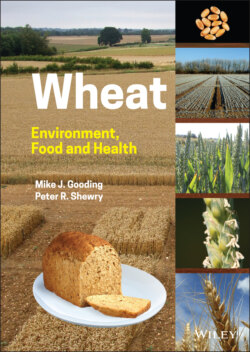Читать книгу Wheat - Peter R. Shewry - Страница 44
1.5.4.4 Importance of Total Protein Concentration
ОглавлениеGluten proteins account for up to 80% of the total grain protein, and their proportion becomes larger with increasing protein concentration. The quantity of wet gluten derived from a flour is, therefore, highly correlated with grain protein concentration. Grain protein concentration is partly determined by genetic factors, with cultivars bred for breadmaking often containing about two percentage points more protein than cultivars bred for livestock feed when grown under the same conditions (Snape et al. 1993). However, there are also strong environmental effects, with protein content ranging between about 6 and 20% due to variation in, for example, temperature, and availabilities of water, N, and S for grain filling (Carson and Edwards 2009; Gooding 2017).
Figure 1.23 Gluten produced by hand washing, stretched to show the cohesive properties.
Source: Taken from Shewry et al. (1995).
Grain protein concentration is not usually determined directly but calculated based on the N concentration determined by chemical analysis (Kjeldahl wet chemistry or Dumas oxidative combustion) or by near‐infrared spectroscopy (NIRS) calibrated based on N analysis (Carson and Edwards 2009). It is often assumed that there is a constant relationship between the amount of N and the amount of protein in biological samples and that the crude protein concentration can be calculated by multiplying the N concentration by a constant factor, with N × 6.25 being most widely used. However, this is not the case because it wrongly assumes that all proteins have a similar N content. Gluten proteins, for example, have higher N contents than most other proteins due to the presence of between 30 and 50% of glutamine, an amino acid which contains two N atoms (as opposed to one in most other amino acids). Consequently, N × 5.7 is widely accepted as a conversion factor for wheat grain and flour (Draper and Stewart 1980). However, this factor is still imprecise as it will vary with the proportion of gluten proteins in the sample. Hence, it will be lower for high protein grain. Similarly, it will be lower for white flour than for wholemeal (with N × 5.83 having been suggested [Kent and Evers 1994]) and vary between mill streams. Nevertheless, it is clearly impractical to use a range of values and a conversion factor of N × 5.7 is almost universally used to calculate protein concentration for marketing and utilization of wheat grain.
Although protein concentration is not the same as protein quality, a minimum protein concentration is required for breadmaking and increasing protein concentration can, to some extent, compensate for lower quality. Hence, higher protein concentrations are required for pasta and breadmaking than for other uses (Figure 1.22). The minimum requirement for the CBP is around 13% DM. Products requiring a weak, extensible dough, such as biscuits, cakes, and pastries, usually require a protein content of less than 10.5% DM and levels down to 9% can be tolerated for some products (Carson and Edwards 2009). Low protein concentrations, and therefore high starch contents, are associated with higher alcohol yields in distilling and bioethanol industries (Taylor et al. 1993).
